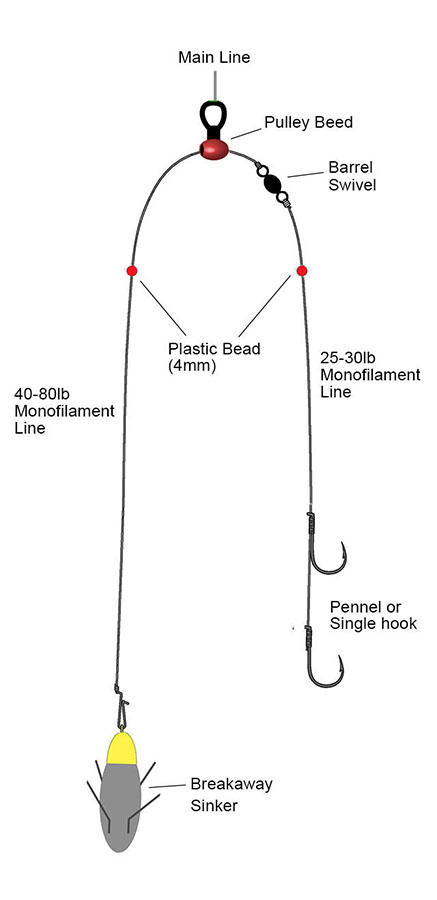The pulley rig is a versatile fishing rig that is ideal for surf fishing and for fishing over rough terrain. It is a British rig that has traditionally been used for fishing rough terrain, but is quicky gaining popularity in the States as a ‘must have’ rig for surfcasting. It’s outstanding for catching a variety of surf sharks and rays.
As a surf fishing rig, the pulley rig is designed for distance casting. It holds the bait down during the cast making the rig more aerodynamic as it flies through the air. It also prevents the hook leader line from tangling with the sinker line. For anglers who need to get their bait out over the surf—and to hold on the bottom—the pulley rig is perfect.

The pulley rig is ideal for fishing in areas with rough bottom. It’s excellent at keeping fish on the line while maneuvering through rough terrain. The fish’s weight helps add downward pressure to the rig, causing the lead weight to slide upward keeping the rig from snagging on the bottom. If by chance the rig snags, the weight releases and the rig and atch is retrieved intact.
If you are looking to target big fish in open water, with long casts over rough terrain, the pulley rig is a great choice. The pulley rig is especially helpful for maneuvering rough terrain and bottom structure upon retrieve.
Pulley Rig setup and specifications
As with most fishing rigs, there are variations galore for creating the pulley rig. Below we’ll outline a basic setup for a simple—yet effective—pulley rig. When setting up a pulley rig for targeting shark and larger fish, you’ll want to increase your material sizes and lengths.
List of materials and items required to make the pulley rig:
- Pulley bead/swivel
The pulley bead, or commonly called a pulley swivel, attaches the main line to the pulley (pennel) rig. You want a large, high quality pulley bead/swivel that can an absorb powerful casting pressure and retrieves. A chain is only as strong as it’s weakest line, so don’t skimp when purchasing a pulley swivel. - Swivel
Size 5 or 6 (80-120lb test) barrel swivel you’ll use to attached the hook leader line to the sinker weight line. The barrel swivel will be attached to the non-hook end of the hook leader line. - Hook leader line
2-6ft of 25-30lb monofilament line. The length you’ll require will depend on the fish type you’re targeting and technique. When targeting larger sharks and rays from shore you’ll want a hook leader line in the 3-4ft range and 125lb test mono. You can also substitute monofilament line with a heavier duty 100-120lb wire leader line or cable. - Breakaway sinker leader line
2-6ft of 40-80lb monofilament for the breakaway sinker weight leader line. The length of the line will depend on the fish type you’re targeting and technique. The length of the sinker leader line should always be greater than then length of the hook leader line. For example, for a shark pulley rig if you use a 3 foot hook leader line you’ll want a 3 1/2 to 4 1/2 foot sinker leader line. - Top hook
1/0 – 6/0 Circle, Aberdeen, or J hook. Any of these hooks will work, but using a Circle for the top hook will ensure a clean hook and release without ‘gut hooking’ the fish. Hook size will depend on target fish species and the size of your rig. - Bottom hook
1/0 – 6/0 Aberdeen or J hook. Size will depend on target fish species and the size of your rig. I typically recommend using a larger size 5/0 – 6/0 hook for general surfcasting. Using two hooks increases the chance of hook up and prevents bait from slipping. - Beads (2)
Two 4-5mm red plastic beads. - Breakaway sinker weight
Must weigh more than the combined weight of the bait and hook leader line. A sinker weight in the 3oz to 5oz range is typical for surf casting. You want the sinker that is big enough for long casts and that will hold to the bottom in heavy surf and tides.
Steps to tie the Pulley Rig
Again, there are several variations for creating the pennel pulley rig. The following steps are for creating a basic pulley rig using the materials listed above.
- Attach the pulley bead/swivel to the main line using an offshore swivel knot, uni knot, or crimp.
- Cut a 2-6ft section of line to create the hook leader line.
- Attach the barrel swivel to one end the hook leader line using an offshore swivel knot or crimp.
- Thread a bead onto the hook leader line.
- Attach your hook(s) to the free end of the hook leader line.
- Cut a 2-6ft section of line to create the sinker leader line. Ensure the length of the sinker leader line is greater than the length of the hook leader line.
- Run one end of the sinker leader line through the pulley swivel attached to the main line, and attach to the barrel swivel.
- Thread a bead onto the sinker leader line.
- Attach the breakaway sinker with hook clip to the free end of the sinker leader line.



